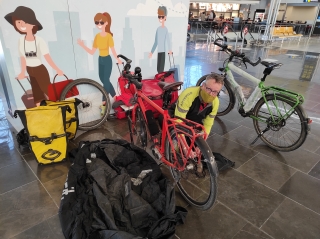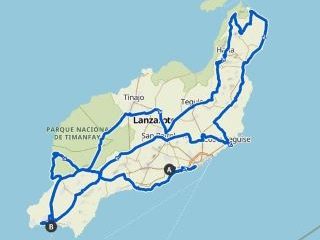
Lanzarote – Fuerteventura – Gran Canaria
(673 km cycled)
Resorts and package deals may be what come to mind when thinking about the Canary Islands. However, the real beauty lies beyond the serviced apartment blocks and all-day-breakfast deals. Our Christmas/New Year trip in Lanzarote, Fuerteventura and Gran Canaria revealed quite distinct landscapes in each island and an absolute cyclists’ paradise.



Arrecife – Playa Blanca – Yaiza – Timanfaya NP – Haría – Mirador del Río – Órzolo – Costa Teguise – Tahiche – La Geria – Playa Blanca
273 km
Lanzarote is like Iceland for beginners! This lunar wonderland boasts an expansive lava field with volcanic craters as far as the eye can see, without the hardship of gravel roads or debilitating headwind. Needless to say, we weren’t alone! It happens to be a winter training ground for iron-man/woman hopefuls and from a logistic perspective, the whole island could be visited on day trips from one base. We chose to move around and stay in villages where possible, which certainly paid off.
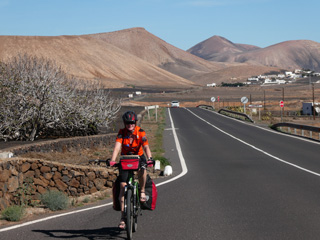

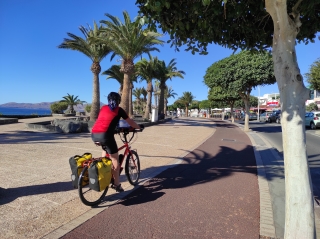
The festive season is a great time to visit these islands as temperatures hover between 20 and 30 degrees Celsius. But the secret is out! Accommodation was low on the ground, and we were forced to adjust our route based on what available and affordable rooms we could find. It meant that we got to stay in a couple of fabulous emblematic/boutique hotels with charming hosts that have invested a lot of TLC into their historic buildings and ensure that their guests are very well looked after: La Casa de los Naranjos in Haría and Hotelito La Era in Yaiza.
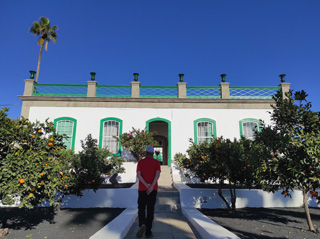



We ended up doing a clockwise loop of the island from Arrecife. The scenery through the centre and out west is absolutely spectacular without any serious climbing involved. The roads are runway material and we experienced very little traffic despite the holiday period.

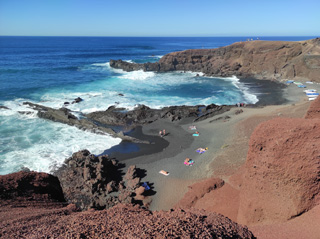


The Timanfaya National Park extends over an area of 50 km2 which was totally covered in ash/lava during the most recent volcanic eruption in Lanzarote (1736). Rusts and browns mingle with blacks and greys in this magnificent showcase of nature. Guided trips on camels or on the official bus are the only way to see the park, and we can highly recommend the 45-minute bus gander up and down the volcanic hills and around the countless craters.

There are even a couple of demos demonstrating the 400-degree temperature below ground: dry hay thrown into a 10m hole bursts into dramatic flames; water shoots up in a spectacular geyser. A hole in the ground generates enough heat to barbeque the meat for the visitor centre restaurant! There are obvious reasons why tourists are not allowed to wander aimlessly around the park!
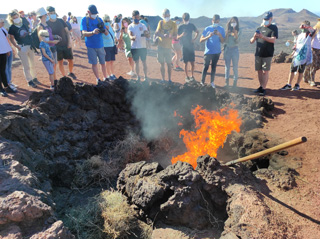


The north of the island is a whole lot greener because of cooler evening temperatures, a damper climate and limited ground water. The cacti are interspersed with fig and almond trees and a string of beautiful white-sand coves complete the picture in this resort-free part of the island.



No trip to Lanzarote would be complete without visiting a couple of César Manrique’s masterpieces. Born in Lanzarote in 1919, Manrique (artist and architect) fought against the huge tourist developments that were being pulled out of the ground at an alarming rate in the 1980s. This vision is probably what saved the island from total commercial destruction and prompted the banning of high-rise hotels. A cross between Gaudí and Hundertwasser, Manrique believed that buildings should blend into the environment and vica-versa. His creations include homes, concert venues, swimming pools, cactus gardens, museums and art galleries, some even in lava tubes.
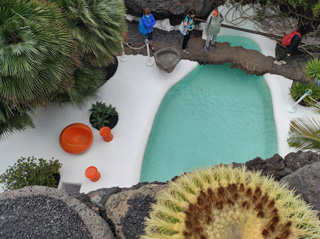



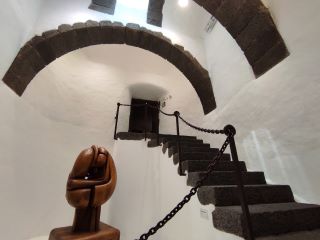
When a volcano erupts and lava starts to flow, the top often hardens as a crust while the lava continues to stream underneath. When the eruption ends and the lava is not replaced, this results in a lava tube or tunnel that can be kilometers long. In the north of the island, we visited the Green Caves and walked 2km through the lava tube, thought to have been formed some 4,000 years ago. Fascinating!


Cycling through black lava fields, the last thing we had expected to find was vineyards. Well, as it happens, the local farmers in La Geria have an ingenious way to grow their vines successfully. They dig out large funnel-shaped hollows in the ground through the volcanic ash until they reach the topsoil. Then they plant their vines and stabilise them with a pile of little volcanic pebbles. The porous nature of the lava stone allows them to absorb dew in the evening and morning and thus irrigate the vines. The hollow also protects the vines from the prevailing north wind that we experienced in this area.



The Malvasía sweet white wine produced here is nothing new and has been exported to England for centuries. Even Shakespeare referred to it in Henry IV:
By my faith you have drunk too much Canary wine, a wonderful and penetrating wine that perfumes blood before it can say: what is this?
The same wine didn’t leave an impression on Kurt, and Darina was much more taken by the Indiana Honey Rum that was often served as a digestif after dinner. In any case, Lanzarote certainly amazed us. It was an easy ride through spectacular scenery with magnificent unique architecture.
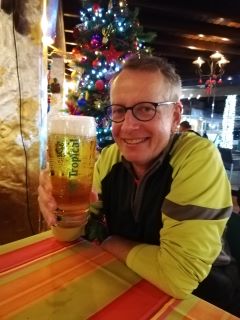
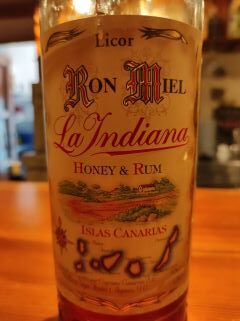
We finished our loop of this stunning island in Playa Blanca to take the 45-minute ferry to Fuerteventura. Lanzarote was going to be a hard act to follow.

Corralejo – La Oliva – Valles de Ortega – Betancuria – Ajuy – Pájara – Morro Jable – Cofete – Morro Jable
207km
Who would have thought that such a short ferry ride would take us to such contrasting scenery? In no time we were cycling through the magnificent Corralejo Dunes Natural Park. Huge white dunes meet the ocean, where kite and wind surfers congregate year-round in idyllic wind and wave conditions. This east coast stretch was a whole lot busier than anything we had experienced in Lanzarote, but the road was wide, and the wind was in our favour. It gave us a real Africa feeling.
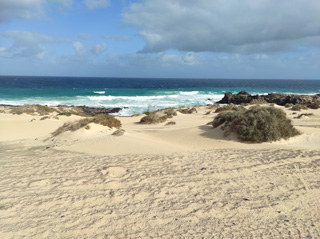
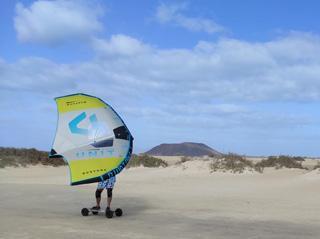

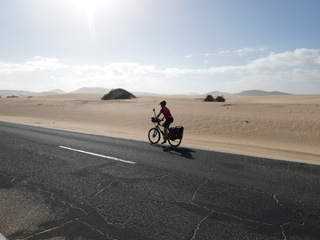

Again, we had to plan our route based on the accommodation available and were lucky enough to land on Curro and Gabi’s doorstep at La Oliva Inn. Curro’s genuine hospitality and ability to bring people together coupled with Gabi’s creativity and attention to detail make La Oliva Inn a real gem of a hostel that could easily be used as a base for visiting the northern half of the island. It was like a home away from home.

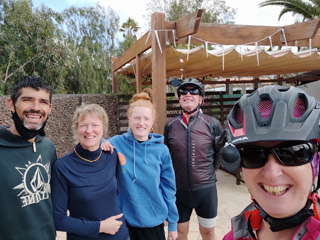
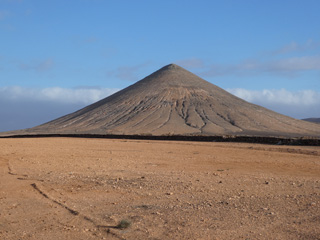
What really sets Fuerteventura apart from Lanzarote is the mountains. Our climbs through the Betancuria and Montaña Cardón areas were at times a hard slog because of the wind, but the views were certainly rewarding. The desolate landscape dotted with isolated farmhouses and tall windmills was quite reminiscent of Patagonia.

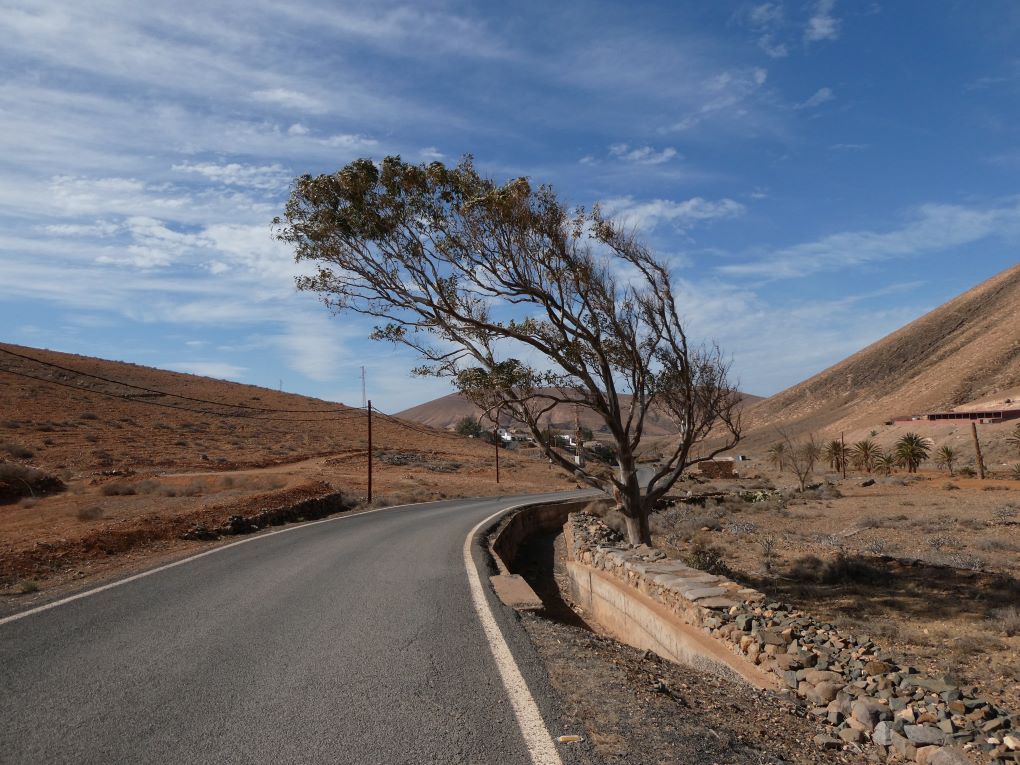


Village churches also had a Latin American feel to them, with very graphic murals to warn against the cruelty of Hell and highlight the merits of aiming for Heaven.
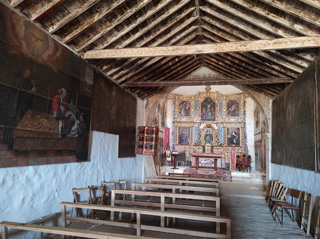

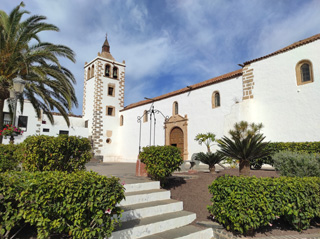
Wind is a recurring theme in Fuerteventura and the island boasts over a thousand windmills. The traditional windmills made of stone, mud and lime were introduced in the 18th century by colonisers and were used for grinding grain. Fuerteventura back then was known as the granary of the Canary Islands. A typical ingredient that has remained in Canary Island cuisine until today is gofio: a toasted flour used in numerous desserts, soups and even a savoury porridge called gofio escaldado.
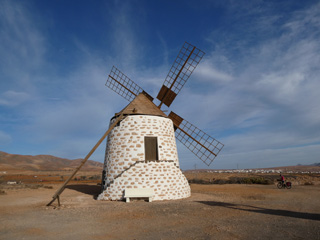
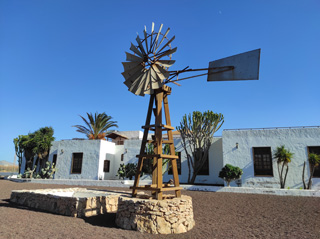
The second type of windmill has a tall wooden trestle base and is used for pumping water. Water is another theme on the island. With very little rainfall and no constant river, the island relies on desalination plants for its tap water and a limited number of reservoirs to store rainwater for agricultural purposes.
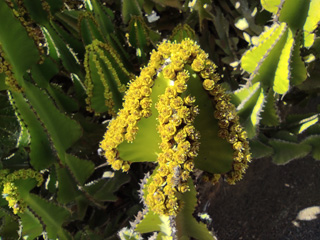

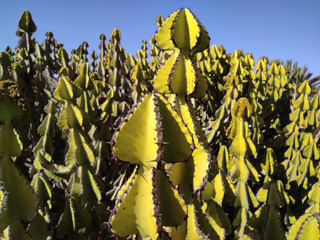
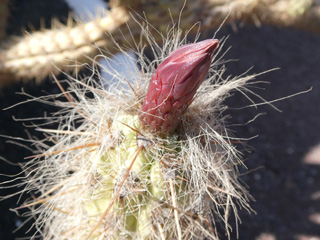
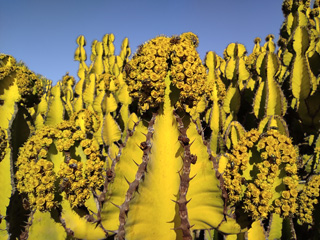

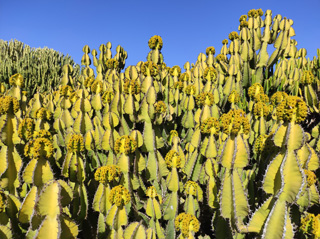


While on Lanzarote we saw very little in the line of farming, in Fuerteventura there were a lot of goats, farmed for their meat and milk. The local goat’s cheese is delicious. However, we were less enthused by the goat meat which was often fried to a crisp. Many farmhouses had a little vegetable garden with potatoes and onions in plentiful supply.

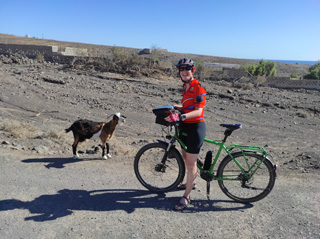

In the middle of nowhere, way down on the Jandía Peninsula in the southwest of the island lies a beautiful villa known as Casa Winter. Built in the 1930s by a German engineer, this villa hides a sinister story that Pedro Fumero, the house caretaker, has been unfolding chapter by chapter these past few years. Pedro remembers his grandfather (former caretaker) telling him how German officials would arrive with one face and leave with another.


Now, decades later as Pedro uncovers underground tunnels leading to the coast, and numerous artifacts including submarine batteries, newspapers, surgical tools, uniforms and badges, Nazi connections are coming to light. Even the cellar layout and furniture have an ominous similarity to those in the Auschwitz concentration camp. Our visit to the house left no doubt in our minds as to the dark past of this enchanting villa. Pedro is a brave man fighting against the clock to have this chapter of history acknowledged before it is turned into a resort by its recent purchasers.
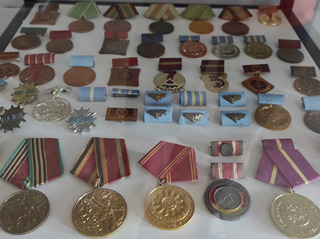

Our 200km route of Fuerteventura avoided the busy east coast in favour of the mountains in the west. Being the oldest island of the Canaries, with the last volcanic activity some 5,000 years ago, adjectives like arid and desolate compete with vast and majestic to describe this unique terrain. Fuerteventura’s attraction lies precisely in the fact that its landscape has not really waited for people. And the wind will probably continue to howl over the rocks even after the last doomsday film has run out of viewers!

Las Palmas – Gáldar – La Aldea de San Nicolas –Tejeda – La Garita – Airport
193km
Gran Canaria was the island on this trip that had a proper big city to offer. Las Palmas de Gran Canaria has a population of almost 400,000, a lovely old town with colonial architecture and a long beach promenade lined with palm trees. It’s definitely worth an explore and we can highly recommend a visit to the Casa de Colón, where Christopher Columbus used to stay en route to the Americas. The exhibitions cover exploration from all sorts of angles and boast a number of historical maps and documents from the 16th century.



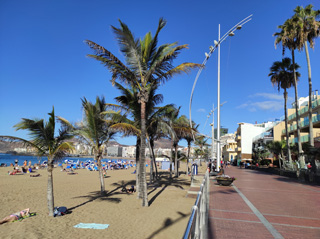
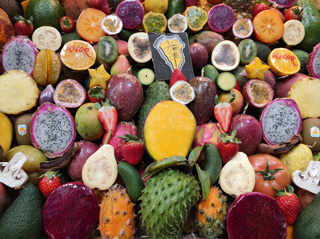
The northern coast is a wild one, but we got to enjoy it from a bike lane leaving Las Palmas and afterwards on a very generous hard shoulder. What also makes Gran Canaria stand out from the other two islands is the amount of shrubbery present making it very green in comparison. Banana and citrus plantations abound and there is no shortage of plastic tunnels with market gardening. Water is in more plentiful supply and picturesque gorges are a dime a dozen.
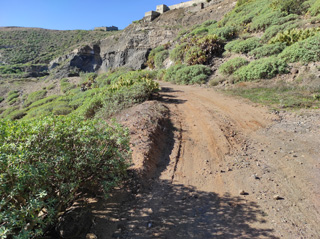
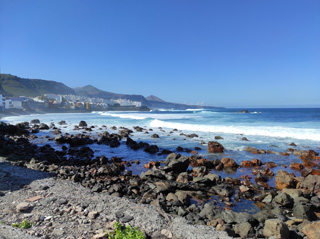



The Canary Islands are thought to have been initially settled by the Guanches (probably a Berber tribe) around 500 BC. They lived a peaceful primitive life until Italians, Portuguese, and Catalans arrived in the 14th century. The Spanish weren’t far behind, and their conquest was fiercely fought by the locals, many of whom chose to take their own lives rather than surrender. It’s a tragic history of slavery and religious conversions; all forgiven by the pope in the name of the Crusades.

Before the arrival of the Europeans, the Guanches had developed quite a number of traditions, the remains of which can be visited today. High up in the hills, they used to carve out caves (Cenobios) into the rocks to store their grain, safely out of harm’s way should pirates go on a rampage. Dwellings were also hollowed out into the rock face, and many are still occupied today. The painted cave in Gáldar, dating back to the 11th century, contains geometrically shaped paintings thought to be a lunar/solar calendar.
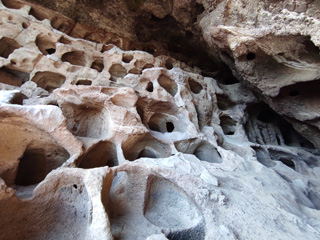

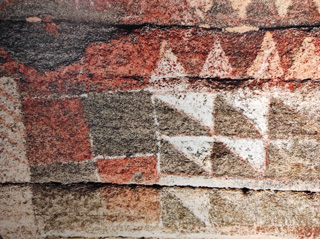
Burials took place in stone graves marked with mounds of stone; the size and shape dictated by the social standing of the deceased. In Maipés Archaeological Park in Agaete there are about 700 tombs possibly dating back 1,300 years.

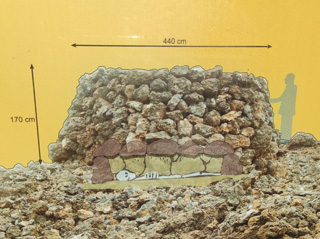
The west coast road meanders in and out up and down the mountain with beautiful views of the coast below. While there is no hard shoulder, we found the truckers very considerate and the ride quite pleasant. What we certainly didn’t expect was the grand welcome we received on approaching a 3km tunnel outside La Aldea. The right lane was immediately reserved for us cyclists and the traffic was diverted to the left lane with constant reminders of our presence. Even without this luxury, the hard shoulder was very generous.

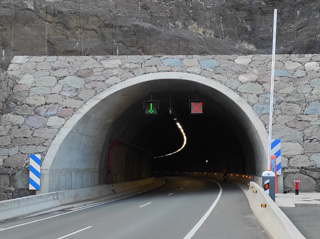
The ride of the whole trip has to be that from La Aldea de San Nicolas to Tejeda. This quiet road leading up to a string of reservoirs with fabulous mountain scenery didn’t come for free though. We climbed 1,200 altitude meters in 34km with another few hundred the next morning before freewheeling back down to the coast.
Around Christmas/New Year it’s not unusual to have strong winds carrying sand/dust from the Sahara thus reducing visibility. This Calima appeared in the late afternoon creating a real mystical atmosphere in the mountains.
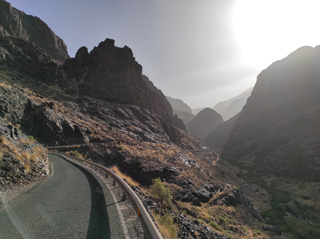
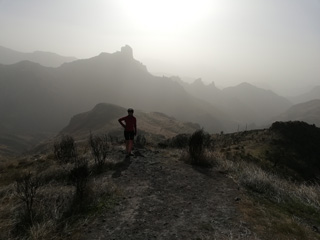
What made the descent special were the almond blossoms in their prime earlier than usual because of a mild winter. Darina spent the day reminiscing about her year in Japan and how based on the cherry-blossom forecast at the end of the TV weather report, the locals would head to the park to picnic and banter into the early hours as the pink confetti marked another beautiful tradition in the annual calendar.
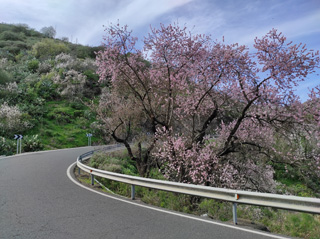

Gran Canaria was our favourite of the three islands. We had the feeling that there was a whole lot of normal life going on that didn’t depend on tourism. The coastal and mountain scenery was second to none and the challenging climbs were duly compensated.



While we had delicious meals on all three islands, Gran Canaria topped the bill for variety and creativity. Papas arrugadas (potatoes with a salty crust) and seafood were the common denominator, while ropa vieja (old clothes) is an amusing term for a casserole made of leftovers! Original desserts included bienmesabe (lit. it tastes good to me), a very sweet almond honey cream, and gofio (toasted flour) was often the preferred flavour of mousse and ice-cream.
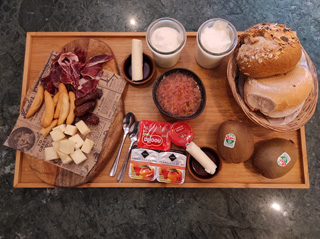
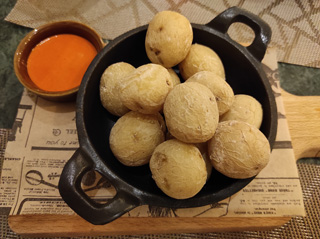
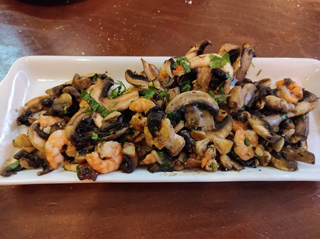
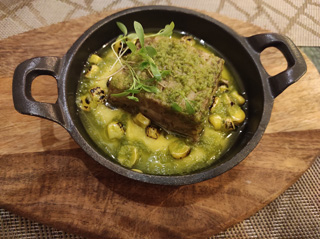

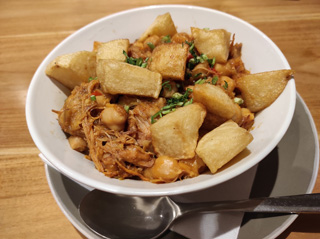
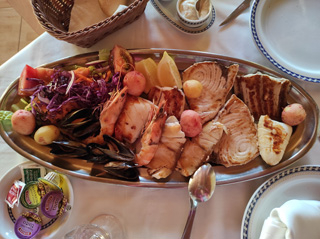
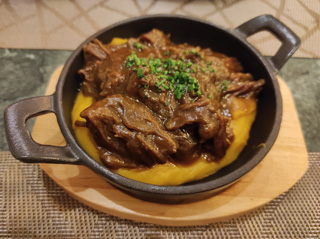
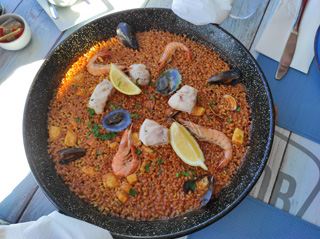
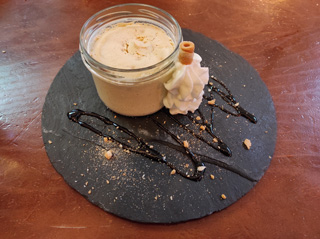
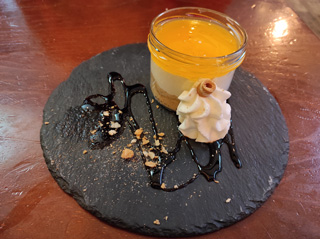
On the whole trip, we found the Canarios exceptionally friendly and very supportive of cyclists, opening their doors to us for a one-night stay even though they would normally only rent their accommodation for a minimum of three nights. And would you believe it – Darina, being a teacher, got in free to all the museums and Kurt got an over-60 discount on the ferries!

The Canary Islands are perfect for a short winter break. These little gems off the coast of Africa offer quite distinct landscapes and different grades of challenge to suit every type of cyclist. Those willing to venture beyond package deals and coastal resorts will certainly be rewarded. Watch this space – there are eight islands in all!

